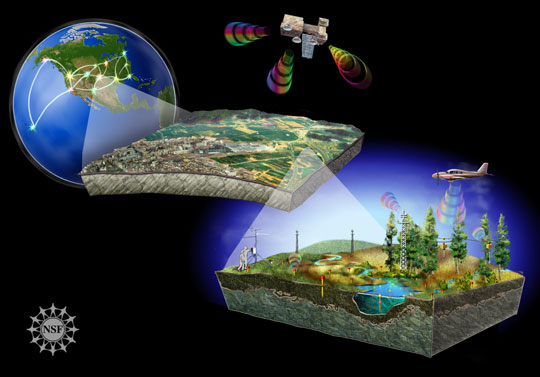
TUSCALOOSA, Ala. – A remote spot within the Talladega National Forest could serve as one of 20 locations nationally that will detect the ecological impacts of climate change.
Each site, instrumented with sophisticated sensors, is part of a first-of-its-kind observatory network designed to measure changes in climate, land use, invasive species and infectious diseases at the continental scale.
Science staff from the National Ecological Observatory Network, known as NEON, recently confirmed 20 sites as Candidate Core Sites, including a site that spans portions of both Bibb and Hale Counties, for the proposed network.
“We are becoming an increasingly interconnected world,” said Dr. Amy Ward, professor of biological sciences at The University of Alabama. “NEON will provide a network that will measure properties of local sites, but link that information to other sites in a national context,” she said.
Ward was tapped in 2004 to help develop guidelines for NEON, the then newly formed national organization proposed by the National Science Foundation.
Towers and other sensors on the candidate sites would measure such things as soil and water properties, air quality and weather conditions. They would also track patterns and changes in organisms, including small mammals, insects, birds, fish and plants. Remote sensing aircraft would periodically track and record changes at the site over time, including shifts in plant diversity.
Data from the network will support collaborative research, a variety of educational initiatives, environmental decision-making, modeling and visualization of data, and enhanced ecological forecasting capabilities.
The sites were chosen because they best represent the ecoclimatic characteristics of their respective domains, according to NEON’s recent news release announcing the sites’ confirmation. Sixteen candidate sites are located in the continental U.S., Alaska hosts two, and Hawaii and Puerto Rico each have one.
The sites would be linked by advanced computer networks to record and archive data for at least 30 years, enough time to monitor ecological trends, the researchers say. One site was selected from each of 20 geographical domains determined by NEON. The Alabama site is within the region designated as the Ozarks Complex.
Under the current plan, NEON Inc. will present its Project Execution Plan at a National Science Foundation Final Design Review in 2009. If construction funds are awarded, the Observatory would be constructed at the sites over a 5 to 7-year deployment.
Obtaining such detailed integrated data will enable scientists to develop more accurate computer models which would predict ecological changes, Ward said.
“The large scale of NEON is a first in the U.S. ecological community,” said Ward, who directs The University of Alabama’s Center for Freshwater Studies. Having access to and involvement with such a large scale ecological project is a boon to University of Alabama researchers, students and the community at large, Ward said.
“Involvement with NEON will set the stage for us to have numerous collaborations with people in the other domains,” she said. “I think it is going to open the door to a whole new level of research and education for our students and many others across the region.”
NEON education and outreach will be focused on preparing society and the scientific community to use Observatory data, information and forecasts. Data collected throughout the network will become a resource for public understanding of ecological issues and for training new generations of scientists to collaborate at the continental scale.
UA’s biological sciences department is part of the College of Arts and Sciences, the University’s largest division and the largest liberal arts college in the state. Students from the College have won numerous national awards including Rhodes Scholarships, Goldwater Scholarships and memberships on the USA Today Academic All American Team.
Under Ward’s direction, UA’s Center for Freshwater Studies is dedicated to understanding and preserving water, the environment in and around it, and the plants and animals, including people, that depend on it. This teaching, research and outreach program draws together faculty from the College of Arts and Sciences, the College of Engineering, the School of Law and the Culverhouse College of Commerce and Business Administration.
Editor’s Note: For more about NEON, visit www.neoninc.org or contact Dan Johnson, 202/628-1500, ext. 215 or djohnson@neoninc.org
Contact
Chris Bryant, Assistant Director of Media Relations, 205/348-8323, cbryant@ur.ua.edu
Source
Dr. Amy Ward, award@as.ua.edu, 205/348-1796